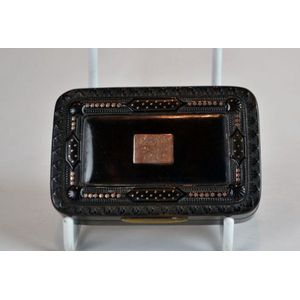Art Deco Onyx & Diamond Ring in White Gold
You must be a subscriber, and be logged in to view price and dealer details.
Subscribe Now to view actual auction price for this item
When you subscribe, you have the option of setting the currency in which to display prices to $Au, $US, $NZ or Stg.
- Onyx - Onyx is a form of agate, used from antiquity and popular again in the 1920s and 30s. European onyx is generally green, but can be many other colours, and can contain bands of black and/or white.
This multicoloured stone is widely used for table tops, lamp bases and in jewellery. Some types of onyx are also used for cameos of which the upper white layer is cut away to reveal the colour beneath. - Brilliant Cut - In their naturally occuring state diamonds have little life or sparkle and for many centuries were simply cut in half and worn in amulets. Invented at the end of the 17th century by a Venetian diamond cutter, a "brilliant cut" diamond has 58 facets arranged in a regular geometric relationship, with 33 above the crown and 25 below on the pavilion.
The introduction of the brilliant cut increased the popularity of diamonds in jewellery as it was the first cut to reveal the fire of the diamond, with the light being internally reflected from one facet to another, and was superior to the previously used table cut and rose cut.Variants to the brilliant cut have emerged since the end of the 17th century, but the popularity of the original brilliant cut has continued to the present time, where it is still the most commonly found cut.
. - Art Deco Period - The Art Deco period was a cultural movement that emerged in the 1920s and 1930s, and was characterized by its emphasis on modernism, luxury, and elegance. The name "Art Deco" comes from the Exposition Internationale des Arts Décoratifs et Industriels Modernes, a large exhibition held in Paris in 1925 that showcased the latest trends in decorative arts.
Art Deco was a reaction against the ornate and elaborate styles of the previous era, and reflected a new modern sensibility. It was characterized by streamlined, geometric shapes, bright colours, and the use of new materials such as chrome, glass, and Bakelite. Art Deco designers sought to create a sense of luxury and sophistication, often incorporating expensive materials such as ivory, marble, and rare woods.
Art Deco had a significant impact on a wide range of artistic fields, including architecture, fashion, graphic design, and interior design. Some of the most iconic examples of Art Deco architecture include the Empire State Building in New York City, the Hoover Building in London, and the Palais de Chaillot in Paris.
The Art Deco period came to an end in the 1940s, as World War II and changing cultural trends led to a shift in artistic styles. However, Art Deco remains an important influence on design and art, and continues to be celebrated for its modernist sensibility and glamorous aesthetic.
This item has been included into following indexes:
Visually similar items

An Edwardian silver embossed quality card case in original Morocco leather box, floral and scroll decoration. Chester 1903 by William Neale

A George III tortoiseshell and gold inlay snuff box late 18th century inscribed initials and bearing date to top of box, height 2.3 cm, width 7.8 cm, depth 5 cm

George IV sterling silver vinaigrette, London 1825, maker Thomas Edwards. Embossed lid, gilt washed interior, including decorated grill. Length 4.5 cm weight 40grams

Georgian sterling silver vinaigrette, hallmarked Birmingham, JL, of rectangular form, with engine turned body, applied floral scroll rim, vacant cartouche, opening to foliate pierced grill, a/f, 1 cm x 4 cm x 2.7 cm
